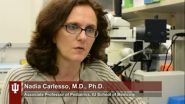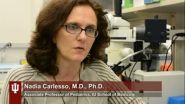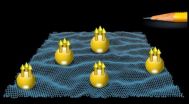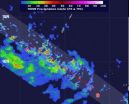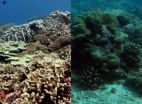(Press-News.org) VIDEO:
Like a line of falling dominos, a cascade of molecular events in the bone marrow produces high levels of inflammation that disrupt normal blood formation and lead to potentially deadly...
Click here for more information.
INDIANAPOLIS -- Like a line of falling dominos, a cascade of molecular events in the bone marrow produces high levels of inflammation that disrupt normal blood formation and lead to potentially deadly disorders including leukemia, an Indiana University-led research team has reported.
The discovery, published by the journal Cell Stem Cell, points the way to potential new strategies to treat the blood disorders and further illuminates the relationship between inflammation and cancer, said lead investigator Nadia Carlesso, M.D., Ph.D., associate professor of pediatrics at the Indiana University School of Medicine.
Bone marrow includes the cells that produce the body's red and white blood system cells in a process called hematopoiesis. The marrow also provides a support system and "home" for the blood-producing cells called the hematopoietic microenvironment. The new research demonstrates the importance of the hematopoietic microenvironment in the development of a group of potentially deadly diseases called myeloproliferative disorders.
"It has been known for years that there are links between inflammation and cancer, but these studies have been challenged by the lack of genetic models, especially for blood-based malignancies," said Dr. Carlesso, a member of the hematologic malignancy and stem cell biology program within the Wells Center of Pediatric Research at IU.
The researchers focused on what happens when there are abnormally low levels of a molecule called Notch, which plays an important role in the process of blood cell production. Using a genetically modified mouse, they found that the loss of Notch function in the microenvironment causes a chain of molecular events that result in excess production of inflammatory factors.
The high levels of inflammation in the bone marrow were associated with the development of a myeloproliferative disorder in the mice. Myeloproliferative diseases in humans can result in several illnesses caused by overproduction of myeloid cells, which are normally are used to fight infections. These diseases can put patients at risk for heart attack or stroke, and frequently progress into acute leukemia and bone marrow failure, which have fatal outcomes. Unfortunately, there are no effective therapies for the majority of myeloproliferative diseases.
When Dr. Carlesso's team blocked the activity of one of the molecules in this biochemical cascade, the myeloproliferative disorder in the mice was reversed. In addition, elevated levels of the blocked molecule were found in samples from human patients with myeloproliferative disease. These findings suggest that developing drugs that target this inflammatory reaction at different key points could be a promising strategy to limit the development of myeloproliferative disease in humans.
The molecular cascade leading to inflammation was not occurring directly in the bone marrow cells that produce blood cells, but in cells of the bone marrow microenvironment, especially in endothelial cells that line the capillaries -- tiny blood vessels -- inside the bone marrow. This was a key discovery, Dr. Carlesso said.
"This work indicates that we need to target not only the tumor cells, but also the inflammatory microenvironment that surrounds them and may contribute to their generation," she said.
"We believe that this combined strategy will be more effective in preventing myeloproliferative disease progression and transformation in acute leukemias."
Dr. Carlesso also noted that the Notch molecule is mostly known as an oncogene -- one that can cause cancer -- and so is often targeted by therapies for other types of cancer. The new research indicates that clinicians need to be aware of the effects that reducing levels of Notch function could have on the blood development process, she said.
INFORMATION:
Dr. Carlesso also is a member of the Indiana University Melvin and Bren Simon Cancer Center.
A short video of Dr. Carlesso discussing her work is here:
http://youtu.be/q5oYaC8xm_g
Additional researchers contributing to this work were Lin Wang, Huajia Zhang, Sonia Rodriguez, Liyun Cao, Jonathan Parish, Christen Mumaw, Amy Zollman, Malgorzata M. Kamoka, Edward F. Srour, Brahmananda R. Chitteti, H. Scott Boswell, Mervin C. Yoder, Xiaolin Tu, Teresita M. Bellido Reuben Kapur and Angelo A. Cardoso, of the IU School of Medicine; Jian Mu and Danny Z. Chen of the University of Notre Dame; Harm HogenEsch of Purdue University; and Taghi Manshouri and Srdan Verstovsek of the MD Anderson Cancer Center.
Funding and support for this research was provided by the National Institutes of Health R01 HL068256, the ITRAC program at IU Simon Cancer Center, the Research Support Funds Grant at Indiana University-Purdue University Indianapolis; the Indiana Center of Excellence in Molecular Hematology (National Institutes of Health P30 DK090948), NIH HL55716 , NIH R01 CA134777 and NIH T35 HL110854-01.
Biochemical cascade causes bone marrow inflammation, leading to serious blood disorders
2014-07-03
ELSE PRESS RELEASES FROM THIS DATE:
How knots can swap positions on a DNA strand
2014-07-03
Physicists of Johannes Gutenberg University Mainz (JGU) and the Graduate School of Excellence "Materials Science in Mainz" (MAINZ) have been able with the aid of computer simulations to confirm and explain a mechanism by which two knots on a DNA strand can interchange their positions. For this, one of the knots grows in size while the other diffuses along the contour of the former. Since there is only a small free energy barrier to swap, a significant number of crossing events have been observed in molecular dynamics simulations, i.e., there is a high probability of such ...
From pencil marks to quantum computers
2014-07-03
Introducing graphene
One of the hottest materials in condensed matter research today is graphene.
Graphene had an unlikely start: it began with researchers messing around with pencil marks on paper. Pencil "lead" is actually made of graphite, which is a soft crystal lattice made of nothing but carbon atoms. When pencils deposit that graphite on paper, the lattice is laid down in thin sheets. By pulling that lattice apart into thinner sheets – originally using Scotch tape – researchers discovered that they could make flakes of crystal just one atom thick.
The name ...
Payback time for soil carbon from pasture conversion to sugarcane production
2014-07-03
The reduction of soil carbon stock caused by the conversion of pasture areas into sugarcane plantations – a very common change in Brazil in recent years – may be offset within two or three years of cultivation.
The calculation appears in a study conducted by researchers at the Center for Nuclear Energy in Agriculture (CENA) of the University of São Paulo (USP) in collaboration with colleagues from the Luiz de Queiroz College of Agriculture (Esalq), also at USP. The study also included researchers from the Federal Institute of Alagoas (IFAL), the Brazilian Bioethanol Science ...
New satellite data like an ultrasound for baby stars
2014-07-03
An international team of researchers have been monitoring the "heartbeats" of baby stars to test theories of how the Sun was born 4.5 billion years ago.
In a paper published in Science magazine today, the team of 20 scientists describes how data from two space telescopes – the Canadian Space Agency's MOST satellite and the French CoRoT mission – have unveiled the internal structures and ages of young stars before they've even emerged as full-fledged stars.
"Think of it as ultrasound of stellar embryos," explains University of British Professor Jaymie Matthews, MOST ...
A young star's age can be gleamed from nothing but sound waves
2014-07-03
VIDEO:
In a young region like the so-called Christmas Tree Cluster, stars are still in the process of forming. A star is 'born' once it becomes optically visible (bottom right). During...
Click here for more information.
Determining the age of stars has long been a challenge for astronomers. In experiments published in the journal Science, researchers at KU Leuven's Institute for Astronomy show that 'infant' stars can be distinguished from 'adolescent' stars by measuring the acoustic ...
Sweet genes
2014-07-03
Edmonton, July 3, 2014 – A research team at the Faculty of Medicine & Dentistry at the University of Alberta have discovered a new way by which metabolism is linked to the regulation of DNA, the basis of our genetic code. The findings may have important implications for the understanding of many common diseases, including cancer.
The DNA wraps around specialized proteins called histones in the cell's nucleus. Normally, histones keep the DNA tightly packaged, preventing the expression of genes and the replication of DNA, which are required for cell growth and division. ...
NASA sees rainfall in newborn Tropical Depression 8W
2014-07-03
Powerful thunderstorms in some areas of newborn Tropical Depression 08W in the Northwestern Pacific Ocean were dropping heavy rainfall on July 3 as NASA's Tropical Rainfall Measuring Mission (TRMM) satellite passed overhead.
The eighth depression of the Northwestern Pacific Ocean season formed on July 3 at 0900 UTC (5 a.m. EDT). It was located near 10.0 north latitude and 144.3 east longitude about 240 nautical miles south of Andersen Air Force Base, Guam. Tropical Depression 08W or TD08W had maximum sustained winds near 30 knots (34.5 mph/55.5 kph) and it was moving ...
Safer, cheaper building blocks for future anti-HIV and cancer drugs
2014-07-03
A team of researchers from KU Leuven, in Belgium, has developed an economical, reliable and heavy metal-free chemical reaction that yields fully functional 1,2,3-triazoles. Triazoles are chemical compounds that can be used as building blocks for more complex chemical compounds, including pharmaceutical drugs.
Leveraging the compound's surprisingly stable structure, drug developers have successfully used 1,2,3-triazoles as building blocks in various anti-HIV, anti-cancer and anti-bacterial drugs. But efforts to synthesize the compound have been hampered by one serious ...
Tropical Storm Douglas weakening in the eastern Pacific
2014-07-03
Tropical Storm Douglas is on a weakening trend, according to the National Hurricane Center, and satellite imagery showed that the storm appeared more elongated on July 3.
NOAA's Geostationary Operational Environmental Satellite or GOES-West satellite captured visible data on Douglas just after sunrise on July 3 at 13:15 UTC (9:15 a.m. EDT). The data from GOES-West was made into an image at NASA/NOAA's GOES Project at the NASA Goddard Space Flight Center in Greenbelt, Md.
Forecaster Stewart at the National Hurricane Center cited that Douglas' thunderstorm activity had ...
Rethinking the reef
2014-07-03
A new study by biologists at San Diego State University and Scripps Institution of Oceanography shows that inhabited coral islands that engage in commercial fishing dramatically alter their nearby reef ecosystems, disturbing the microbes, corals, algae and fish that call the reef home.
The study's lead author, Linda Wegley Kelly, is a postdoctoral scholar in the lab of SDSU virologist Forest Rohwer.
For the study, she looked at seawater samples collected from the surfaces of reefs surrounding all 11 of the Line Islands, a chain of atolls in the central Pacific Ocean. ...
